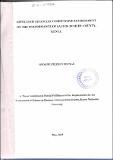| dc.description.abstract | The major function of savings and credit co-operative society is to receive contributions from members and give Joans to members at competitive rates of interests. For a Jong period SACCO has operated a closed shop type of business enjoying almost monopoly power on its market niche without any competition from other institutions. This has made the SACCO to relax and forget to continuously advertise its products, diversify its services and improve their quality as well as innovate of new products. Today SACCO has been caught unaware by commercial banks that have aggressively penetrated into its business circles by introducing the unsecured loans targeting members of public including the members of the SACCO. Many studies had concentrated on efforts on the shortcomings of the co-operative laws in general and lending policies particular in the promotion, development and operations of savings. They had overlooked the aspect of liberalization which has brought new changes and made financial sector more competitive. The study was motivated by rivalry and competition in the SACCO sector which caused ripples in the SACCO business that the print media and the press had described as "banks battle it out for potential customers with SACCO". The study was intended to investigate the effects of financial competitive environment on the performance of Saccos. The variables of the study were technology, net expansion, products development and agency banking. The target population of the study was 56 credit managers of the Saccos at Meru County. Due to the population size of the credit managers of 56 Saccos in Meru County, the research used census approach. Both primary and secondary data collection method was used. Primary data was collected by use of questionnaires while secondary data was obtained from Sacco annual audited accounts and websites. In addition, the study used Cronbach' s Alpha to test the reliability of the instruments. The following theories were used, traditional banking theory, finance theory, modern portfolio theory and Joan pricing theory. 30% of the respondents indicated that the Sacco had an Auto branch while 70% of the respondents said that their Sacco did not have an Auto branch. Majority 90% of the respondents indicated that the Sacco's had not adopted agency banking while only 10% of the respondents indicated that the Sacco had adopted agency banking in their operations. There also existed a strong and positive correlation between net expansion and agency banking with a correlation coefficient of 0.579 and significance level of 0.0389. The correlation was statistically significant since its P- value was less than 0.05. According to the findings, technology, agency banking, product portfolio were important factors in influencing the performance of Sacco's since their P values were less than 0.05 for all the variables except net expansion which had a P value of more than 0.05. It is therefore recommended that Sacco's should adopt banking, use MIS, and improve their product portfolio. | en_US |

